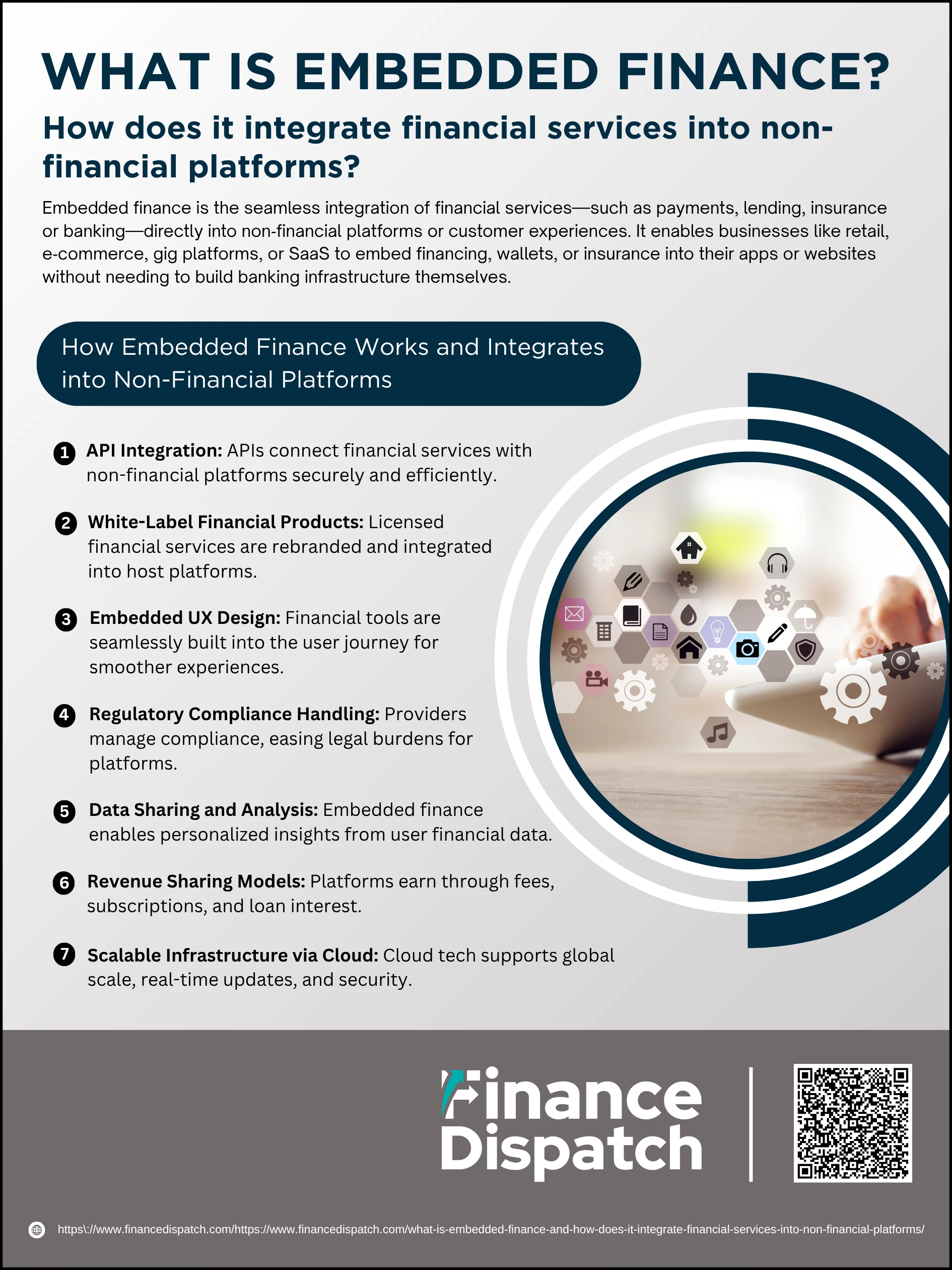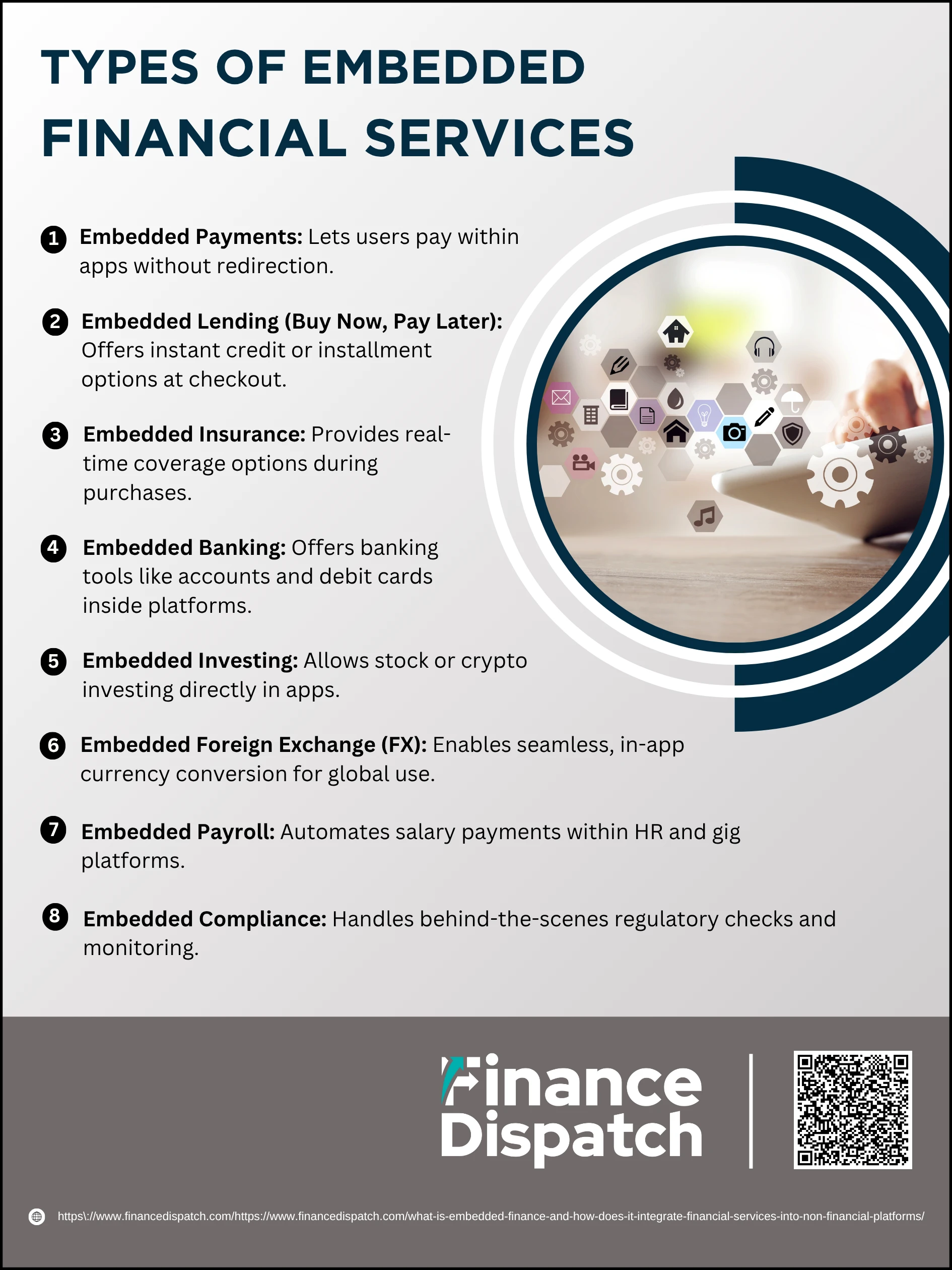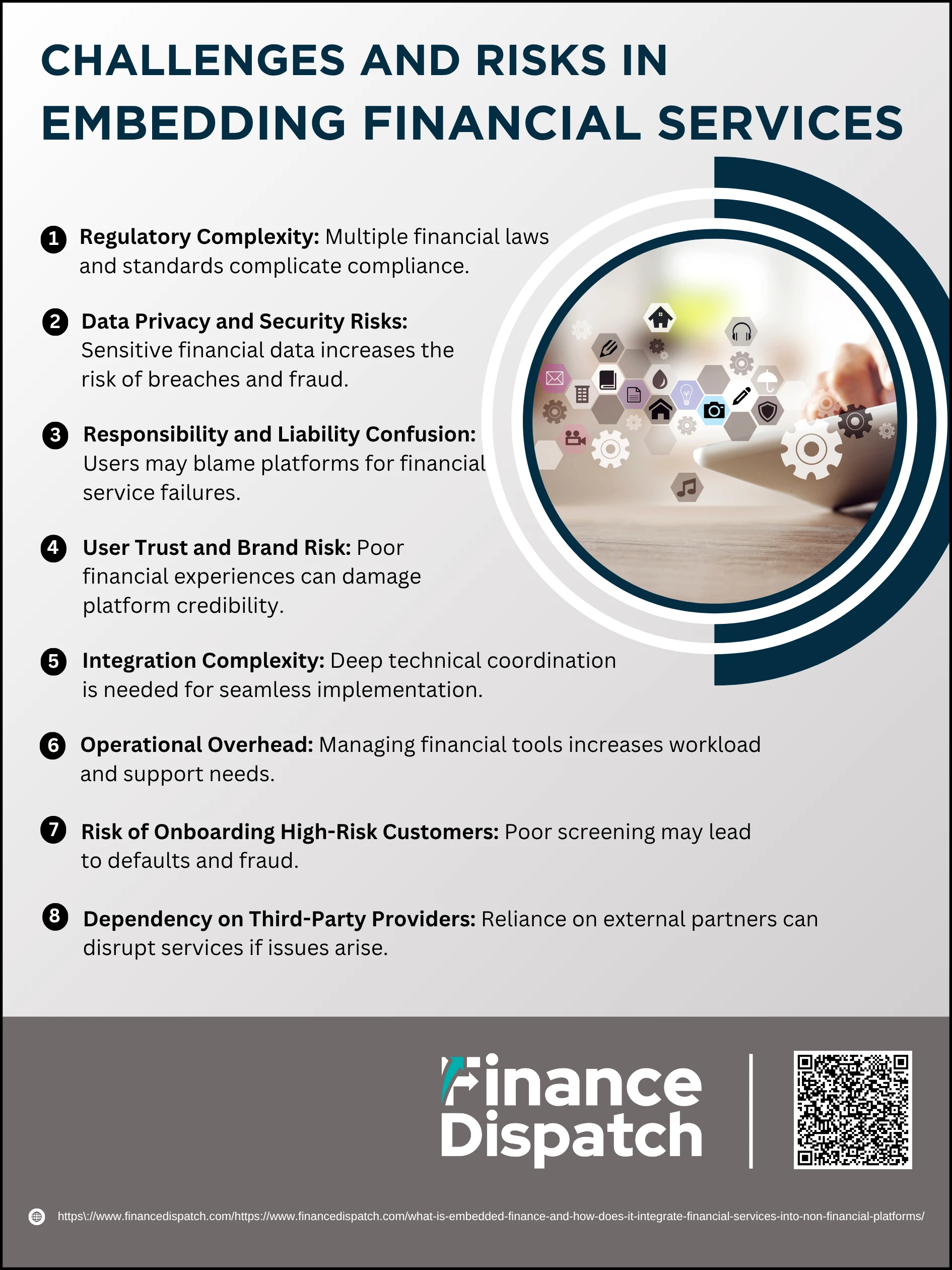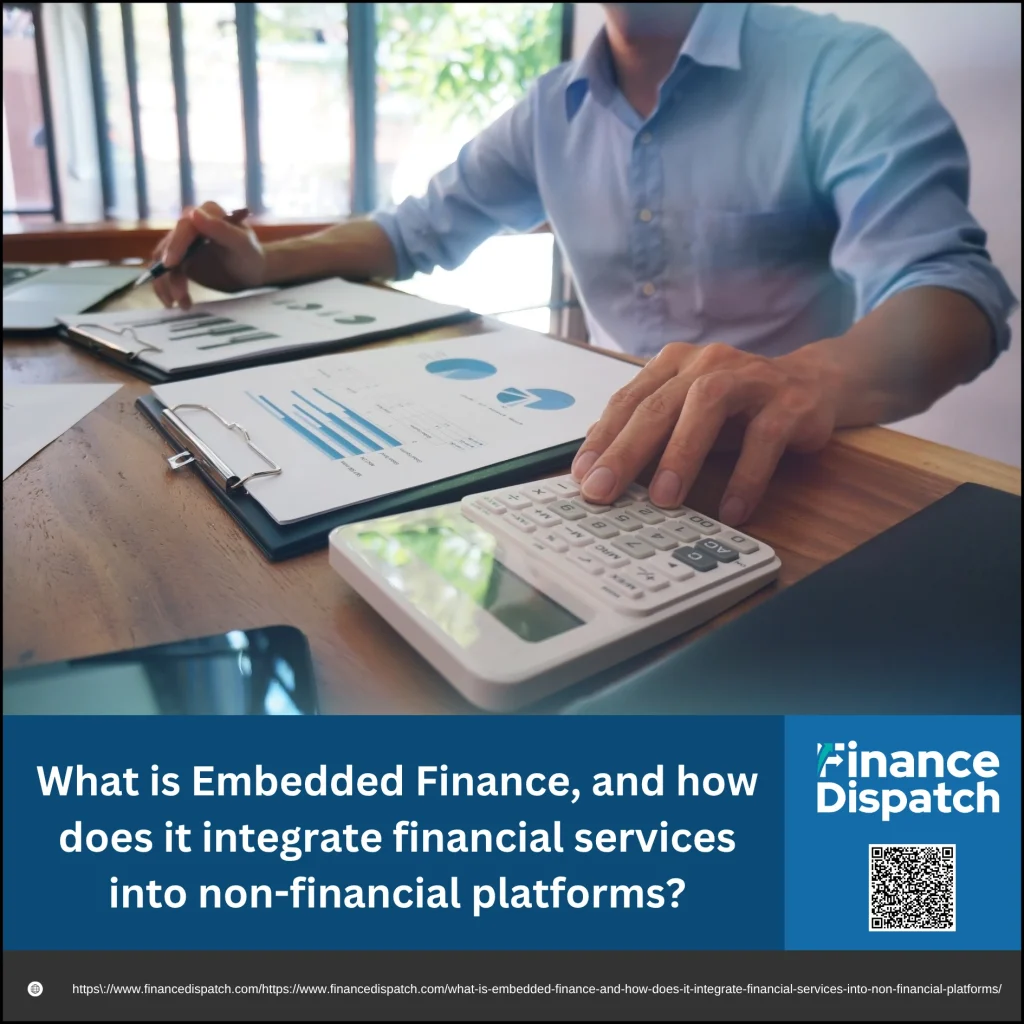In today’s digital-first economy, consumers expect seamless, instant access to everything—from shopping and travel to financial services—all within the same platform. This is where embedded finance steps in. It refers to the integration of financial products such as payments, lending, insurance, or banking into non-financial platforms like e-commerce sites, ride-sharing apps, and software-as-a-service (SaaS) tools. Instead of redirecting users to traditional banks or third-party portals, embedded finance allows businesses to offer these services natively within their own user interfaces. Whether it’s paying for a ride in the Uber app, accessing a business loan through Shopify, or insuring a Tesla at the point of purchase, embedded finance creates a frictionless experience that benefits both businesses and customers. As technology continues to evolve, this convergence of financial services and digital platforms is reshaping the future of commerce, finance, and customer engagement.
What is Embedded Finance?
Embedded finance is the seamless integration of financial services—such as payments, lending, insurance, banking, and investing—into platforms and applications that are not traditionally part of the financial industry. Instead of using a separate app or visiting a bank, users can access these financial tools directly within the services they already use daily. For example, a customer booking a ride through a ride-sharing app like Uber can pay within the app without needing to enter payment details repeatedly, while a business using Shopify can access capital or banking features without leaving the platform. At the core of embedded finance is the use of APIs (Application Programming Interfaces), which allow non-financial companies to connect with licensed financial providers and deliver these services under their own brand. This not only streamlines user experience but also opens new revenue opportunities and builds stronger customer loyalty for businesses.
 How Embedded Finance Works and Integrates into Non-Financial Platforms
How Embedded Finance Works and Integrates into Non-Financial Platforms
Embedded finance enables businesses outside the traditional financial sector to offer services like payments, lending, insurance, and investing directly within their apps or websites. This seamless integration enhances the user experience by keeping financial transactions inside the platforms users already trust and use. Let’s break down how this process works step by step.
1. API Integration
APIs (Application Programming Interfaces) are the backbone of embedded finance. They allow different software systems—such as a retailer’s app and a bank’s system—to communicate securely and efficiently. By using APIs, a non-financial company can quickly embed banking features like account creation, payment processing, or lending offers into its platform without building the infrastructure from scratch. This makes implementation faster and more cost-effective.
2. White-Label Financial Products
Most embedded finance services are offered as white-label products. This means the financial service—be it a digital wallet, a debit card, or an insurance offering—is provided by a licensed financial institution, but it is branded and offered as part of the host platform’s ecosystem. For example, a retail app might offer its own “Store Credit Card” powered by a third-party bank, giving the illusion of an in-house financial service while using the infrastructure of a licensed provider.
3. Embedded UX Design
To truly be embedded, financial services must feel like a natural part of the customer journey. This involves UX/UI (User Experience/User Interface) design that integrates features like one-click payments, financing options at checkout, or real-time insurance quotes during booking. The key is that users don’t need to be redirected to a third-party app or website—everything happens within the original platform, creating a smoother and more engaging experience.
4. Regulatory Compliance Handling
Financial services are highly regulated. When a business offers embedded finance, it must comply with laws such as KYC (Know Your Customer), AML (Anti-Money Laundering), and data privacy standards like GDPR or PCI-DSS for card transactions. To simplify this, most embedded finance providers take on the responsibility for regulatory compliance. This means the non-financial company doesn’t have to become a licensed financial institution, making it easier to offer compliant services.
5. Data Sharing and Analysis
Once embedded, these services generate valuable financial data. This includes user behavior, spending habits, creditworthiness, and more. Through secure, encrypted data sharing between the platform and the financial partner, businesses can gain actionable insights. They can then personalize product recommendations, improve marketing strategies, and offer tailored financial solutions, such as pre-approved loans or custom insurance plans.
6. Revenue Sharing Models
Embedded finance creates new income streams for non-financial companies. For instance, platforms may earn a percentage of each transaction (interchange fees), take a cut from interest on loans or BNPL (Buy Now, Pay Later) repayments, or charge subscription fees for value-added financial services. This turns what was once a cost center—like payment processing—into a monetizable feature.
7. Scalable Infrastructure via Cloud
Cloud technology supports the rapid scaling of embedded finance across geographies and customer bases. With cloud infrastructure, platforms can handle high transaction volumes, integrate new services, and launch in multiple markets without large upfront investment. It also enables real-time updates, automated security patches, and global service availability, which are essential for maintaining trust and performance in financial services.
 Types of Embedded Financial Services
Types of Embedded Financial Services
Embedded finance has revolutionized how users interact with financial tools by bringing them directly into non-financial platforms like e-commerce sites, mobile apps, and SaaS solutions. These services are no longer exclusive to traditional banks. Instead, they are seamlessly woven into user experiences, offering convenience, speed, and personalization. Let’s explore the main types of embedded financial services reshaping digital ecosystems today:
1. Embedded Payments
This is the most common form of embedded finance. It allows users to make purchases directly within an app or platform without being redirected to a third-party payment page. Examples include in-app ride payments (Uber), one-click checkouts (Amazon), or mobile wallets (Apple Pay, Google Pay). It streamlines transactions, reduces cart abandonment, and enhances user satisfaction.
2. Embedded Lending (Buy Now, Pay Later)
Embedded lending allows customers to access credit or installment payment options at the point of need—usually during checkout. Services like Klarna, Afterpay, and Affirm enable customers to split payments into manageable installments without using a traditional credit card. For businesses, it helps increase order value and conversions.
3. Embedded Insurance
With embedded insurance, customers can opt for coverage right within the purchasing process. Whether it’s travel insurance added to a flight booking or product protection during electronics checkout, this service makes insurance more accessible and relevant. It eliminates the need to seek out third-party insurance providers.
4. Embedded Banking
This involves offering banking functions like checking accounts, savings, and debit cards within a non-bank platform. For example, ride-sharing services may offer drivers in-app bank accounts or instant earnings. Shopify Balance is another example, where business owners access financial tools without opening a separate bank account.
5. Embedded Investing
Non-financial platforms like social media apps or personal finance tools now allow users to invest in stocks, ETFs, or cryptocurrency directly through their interface. Apps like Cash App, Robinhood, and Acorns make investing part of the daily digital experience, often targeting younger, mobile-first users.
6. Embedded Foreign Exchange (FX)
This service allows users to perform real-time currency conversions within platforms that operate globally. E-commerce sellers and gig economy platforms often use embedded FX tools to manage international payments, convert currencies, and reduce foreign transaction costs without leaving the platform.
7. Embedded Payroll
Payroll services are being integrated into HR and gig-economy platforms. These tools allow businesses to calculate salaries, withhold taxes, and transfer wages seamlessly. For example, some freelance marketplaces now offer direct payouts to service providers through embedded financial partners.
8. Embedded Compliance
Though less visible to users, embedded compliance ensures that services like KYC, AML screening, and transaction monitoring are handled automatically in the background. This allows platforms to onboard users faster while remaining compliant with regulations without managing the legal burden themselves.
Key Players in the Embedded Finance Ecosystem
The embedded finance ecosystem is made up of a dynamic network of participants, each playing a crucial role in delivering seamless financial services through non-financial platforms. From traditional banks to cutting-edge fintech companies, these players work together to power services like payments, lending, insurance, and investments behind the scenes. Their collaboration ensures regulatory compliance, technological integration, and exceptional user experiences—all without requiring customers to leave the platforms they already use.
Here are the key players in the embedded finance ecosystem:
1. Fintech Companies
These are the technology providers that develop APIs and infrastructure enabling the integration of financial services. They offer white-label solutions in payments, lending, card issuing, and more. Examples include Stripe, Plaid, and Marqeta.
2. Traditional Banks and Financial Institutions
They provide the regulated financial products—such as loans, bank accounts, and payment rails—used in embedded finance. Banks often partner with fintechs or platforms to extend their services beyond their own apps.
3. Non-Financial Platforms and Brands
These are the customer-facing businesses (like e-commerce sites, ride-sharing apps, or SaaS tools) that embed financial services into their offerings. They focus on user experience and distribution, rather than building financial products from scratch.
4. Embedded Lenders
These players provide credit or lending solutions integrated into platforms. Services like Buy Now, Pay Later (BNPL) are commonly powered by embedded lenders such as Affirm, Afterpay, or Klarna.
5. Banking-as-a-Service (BaaS) Providers
BaaS companies serve as intermediaries that enable non-financial platforms to offer bank-like features (accounts, cards, compliance) without becoming licensed banks themselves. They handle licensing and backend operations.
6. Payment Service Providers (PSPs)
These firms specialize in processing transactions within embedded environments. They enable real-time payments, split payments, and recurring billing. Examples include Adyen and PayPal.
7. Regulatory and Compliance Partners
These ensure embedded services follow financial regulations like KYC (Know Your Customer), AML (Anti-Money Laundering), and data protection standards. They’re critical in managing trust and safety.
8. Technology Integrators and Developers
These include software development teams and third-party agencies that help businesses implement and maintain embedded financial tools on their platforms.
Benefits of Embedded Finance for Platforms and Users
Embedded finance delivers powerful advantages to both the platforms that integrate financial services and the users who interact with them. For platforms, it unlocks new revenue streams, deeper customer insights, and enhanced loyalty by embedding services directly into their ecosystems. For users, it offers convenience, speed, and personalization—eliminating the need to switch apps or visit a bank. The result is a win-win model that simplifies financial interactions while increasing value on both sides.
Below is a table highlighting the core benefits for each stakeholder:
| Stakeholder | Key Benefits | Explanation |
| Platforms / Businesses | New Revenue Streams | Earn through transaction fees, interest margins, subscriptions, or upselling embedded financial products. |
| Increased Customer Loyalty | Seamless, value-added services (like in-app payments or lending) encourage users to stay within the platform. | |
| Access to Rich Data | Platforms gain insights into customer behavior and financial preferences, enabling personalization. | |
| Competitive Differentiation | Offering built-in finance tools helps platforms stand out in crowded markets. | |
| Reduced Regulatory Burden | Most compliance responsibilities (KYC, AML, licensing) are managed by embedded finance providers. | |
| Users / Customers | Greater Convenience | Users can make payments, apply for loans, or buy insurance without leaving the app they’re using. |
| Faster Transactions | Real-time processing and instant access to services reduce delays. | |
| Personalized Services | Embedded finance often uses customer data to tailor credit, insurance, or investment options. | |
| Lower Costs | Some services like BNPL offer interest-free installments, and digital wallets reduce banking fees. | |
| Enhanced Trust | Users feel more secure when financial actions take place in familiar platforms with seamless UX. |
 Challenges and Risks in Embedding Financial Services
Challenges and Risks in Embedding Financial Services
Embedded finance is transforming how users access banking, lending, insurance, and investment services—but it’s not without its complexities. As more non-financial platforms integrate financial tools to improve user experience and drive revenue, they must also address a variety of operational, legal, and technical risks. These challenges can affect customer trust, regulatory standing, and the long-term viability of embedded offerings. Below is a detailed look at the most critical hurdles businesses may face when embedding financial services.
1. Regulatory Complexity
Embedded finance spans multiple financial services—each governed by strict and evolving regulations. Compliance with frameworks like KYC (Know Your Customer), AML (Anti-Money Laundering), GDPR (data protection), and PCI-DSS (payment security) is mandatory. Even if the embedded finance provider assumes the regulatory burden, the host platform is still tied to the customer relationship and may share accountability for violations or compliance failures.
2. Data Privacy and Security Risks
Financial services involve the collection, storage, and transfer of highly sensitive personal and financial data. This makes embedded finance platforms attractive targets for cyberattacks and data breaches. Poorly secured APIs, weak encryption, or misconfigured access controls can lead to financial fraud, identity theft, and loss of customer trust. Ensuring airtight data governance and cybersecurity is critical.
3. Responsibility and Liability Confusion
In an embedded finance model, customers often don’t know where the financial service ends and the platform begins. If a loan gets declined, a transaction fails, or insurance isn’t honored, customers are likely to blame the host platform—even if the issue stems from the underlying financial provider. This blurred line of responsibility can lead to legal disputes, customer complaints, and damage to the brand’s credibility.
4. User Trust and Brand Risk
Trust is the foundation of any financial transaction. If users encounter unexpected fees, poor service, or unresolved issues within an embedded financial product, it directly reflects on the platform offering it. A single negative financial experience—whether or not the platform is technically at fault—can cause lasting damage to user perception and retention.
5. Integration Complexity
Successful embedding of financial services requires more than just connecting APIs. It involves front-end design, backend system integration, payment gateways, fraud prevention layers, and responsive user support—all tightly woven into the platform’s core. Without deep technical coordination, the result can be clunky, unreliable, or inconsistent financial experiences.
6. Operational Overhead
Introducing embedded financial tools adds new demands: managing disputes, handling payment failures, overseeing transaction reporting, and responding to compliance audits. This operational overhead—if underestimated—can slow down the platform’s core business and overwhelm customer service teams.
7. Risk of Onboarding High-Risk Customers
When offering embedded credit or financial accounts, platforms may attract users who are financially unstable or prone to fraud. Without robust screening, this can lead to increased default rates, chargebacks, and potential regulatory violations, especially if identity verification or credit assessments are inadequate.
8. Dependency on Third-Party Providers
Platforms rely heavily on fintech providers, BaaS (Banking-as-a-Service) partners, or API vendors to power their embedded financial services. If a provider faces an outage, loses a license, increases costs, or exits the market, the platform’s offerings may be abruptly disrupted. This dependency makes vendor selection and contingency planning critically important.
The Evolution and Future of Embedded Finance
Embedded finance has come a long way from its early roots in private-label credit cards and retail financing programs. Initially, it served as a bridge between banks and consumers through third-party retailers and service providers. However, with the rise of mobile technology, APIs, and cloud computing, embedded finance has evolved into a seamless, digital-first experience. Today, companies like Uber, Shopify, and Tesla integrate payments, banking, insurance, and lending directly into their user interfaces—no longer as add-ons, but as core features. As we look to the future, embedded finance is expected to expand across industries like healthcare, education, real estate, and travel, offering hyper-personalized financial products powered by AI and real-time data. Regulatory bodies are also becoming more open to innovative models, which will likely accelerate adoption. Ultimately, the future of embedded finance lies in its ability to make financial services invisible, intuitive, and accessible—delivered exactly when and where users need them most.
Conclusion
Embedded finance is reshaping the way financial services are delivered and experienced, bringing them directly into the everyday platforms people use for shopping, travel, business, and more. By seamlessly integrating tools like payments, lending, insurance, and investing into non-financial apps and websites, businesses can enhance user experience, drive loyalty, and unlock new revenue streams. At the same time, consumers benefit from faster, more convenient, and often more personalized financial options. While challenges such as regulatory compliance and data security must be carefully managed, the long-term potential of embedded finance is vast. As technology advances and user expectations evolve, embedded finance is set to become a foundational element of the digital economy.



